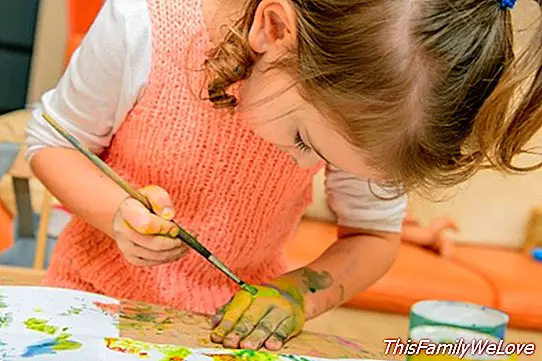The importance of creativity in childhood

The creativity it can be defined as the ability to develop and express human potential from different integrative areas of the human being: cognitive and intellectual (of knowledge and thought), volitional and behavioral, and affective. This is resolved within an environment conducive to free thought, without judgments or conditioning of the previous characteristics.
Education seeks methodologies that allow developing the qualities and competences of the individual in general, and of the child in particular, from an environment that facilitates free thinking, with tools that can be made available for the discovery of new forms of use and search for alternatives to the solution of a problem or a given situation. From different disciplines, the unconscious part of the brain has been treated as a propellant of creativity.
How to cultivate creativity since childhood?
The family, as the first group of social interaction of the human being, is a special and unique means that can favor or hinder the awakening of creativity.
If the culture that is created in a family has the characteristics of being an open, tolerant family, with gestures of acceptance and unconditional love in the child, he will be invited to explore for himself, to reflect, to conquer his autonomy by doing things for itself and solving difficulties; what will help you to resolve conflicts, to establish relationships of trust and affection, and to acquire a positive self-concept with an adjusted self-esteem, capable of facing new situations, adapting to the norms and creating new ones based on empathy and respect for oneself and others, and learn from difficulties and mistakes with a certain tolerance for frustration.
As in school, where the child begins to live with their peers and other adults. He realizes that it is not necessary to have the same ideas to carry out a task, nor the same logic in his way of thinking to solve problems. He learns that with creativity he discovers his surroundings better and those who accompany him, and he is a creative and creative being, that there is no one reality for everyone, and that several options may be valid. This is thanks to the creation of a space and an environment that defends tolerance, knowledge and learning through the discovery and free expression of interpretations from their movements, plastic expression (drawing) and communicative expression according to basic rules of coexistence and respect. To do this, the teacher must encourage creative thinking, and since the game is a good gateway.
Resources that favor creativity
1. The game. The game helps to relax, to feel free of conditioning, to learn while enjoying what you experience, and to generate good humor. Good humor is directly connected to the brain's development of creativity, and helps to better remember what is lived. It also encourages spontaneity, intuition, fantasy, the ability to analyze, to know new perspectives, and positive experiences with other people that will be part of our emotional memory.
2. The music. Music activates lateral thinking, which allows us to combine different areas of our brain to enrich the more rational area with the intuitive one. Music is universal, it activates different moods and with the different emotions we experience we can adopt different positions in the same situation, investing previous structures and generating changes.
3. The drawing. Drawing as an expression has also been a well-studied medium, drawings from an early age are the same in children from different countries or cultures, with different economic levels and with different resources at their disposal. In fact, an evolution of the drawing is studied, and in particular of the human figure in childhood, with a remarkable evolution from 3 to 6 years. If we allow expressing through the drawing it is advisable to allow a free drawing, without trying to interpret what the child expresses, since it will not be good or bad, it will be his work, his expression. With assessments from our interpretation we would be sending messages that would condition the child's way of expressing himself, and therefore how he sees his reality, to adapt to the approval of the adult, and not of his own personal development.
4. Other resources, such as creative writing, body language, creative reading, metaphors and paradoxes, reflective and provocative questions, and visualization. Visualization is very useful in children, since they have great imaginative ability to create different scenarios of reality in which they can resolve conflicts and reach a level of well-being in a natural way, while helping them to calm down and turn them into children more reflective and flexible in the search for alternatives.
Qualities that favor creativity
The qualities that favor creativity, according to Torrance (1978) based on school and family education are:
1. Curiosity
2. The flexibility
3. Self-confidence
4. Sensitivity to the problems that occur around them
5. Creativity
6. The redefinition of problems and situations
7. The originality
8. The capacity for perfection, not conformism
In conclusion, the key to creativity is the motivation to do something creative. What makes it more fun. We should educate enjoying, and enjoy while we educate.
Raquel de Diego. Coach specialist in coaching for families and couples. Conciliafam
It may interest you:
- Creativity in childhood fosters entrepreneurship
- Ideas to enhance creativity at home
- Creativity in children, how to develop it on a day-to-day basis




